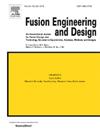Design and implementation of antenna control system for EAST ECRH
IF 1.9
3区 工程技术
Q1 NUCLEAR SCIENCE & TECHNOLOGY
引用次数: 0
Abstract
The antenna system constitutes an essential component of the Electron Cyclotron Resonance Heating (ECRH) system, which is employed to inject high-power millimeter waves precisely to the specific internal resonance layer required for EAST experiments, realizing plasma heating, current driving, and magnetohydrodynamic (MHD) instability control. Therefore, an ECRH antenna control system was designed to fulfill the above requirements. The system employs the NI CompactRIO controller as the lower computer and utilizes LabVIEW as the programming language for software development. This paper decomposes the software architecture into functional modules and elaborates on the servo motor motion control module. Furthermore, the motor servo control system is modeled and simulated in MATLAB/Simulink. Then the response-time testing and position followability testing are carried out on the test bench. The measured response time of the small-angle scanning motion of the SM was less than 50 , and the index values for tracking error of the light spots are within the range of 0.1 to 1. The test results demonstrate that the antenna control system exhibits high position control accuracy and excellent response performance, which holds significant application value for the investigation of Experimental Advanced Superconducting Tokamak (EAST) experiments, as well as providing a valuable reference for the development of similar control systems in the future fusion reactors.
为 EAST ECRH 设计和实施天线控制系统
天线系统是电子回旋共振加热(ECRH)系统的重要组成部分,用于向 EAST 实验所需的特定内部共振层精确注入高功率毫米波,实现等离子体加热、电流驱动和磁流体动力学(MHD)不稳定性控制。因此,我们设计了一套 ECRH 天线控制系统来满足上述要求。该系统采用 NI CompactRIO 控制器作为下位机,并使用 LabVIEW 作为软件开发的编程语言。本文将软件结构分解为多个功能模块,并对伺服电机运动控制模块进行了详细阐述。此外,还在 MATLAB/Simulink 中对电机伺服控制系统进行了建模和仿真。然后在试验台上进行了响应时间测试和位置跟随性测试。实测的 SM 小角度扫描运动响应时间小于 50 ms/1∘,光斑跟踪误差指标值在 0.1 至 1 范围内。 测试结果表明,该天线控制系统具有较高的位置控制精度和优异的响应性能,对先进超导托卡马克(EAST)实验的研究具有重要的应用价值,同时也为未来聚变反应堆类似控制系统的开发提供了宝贵的参考。
本文章由计算机程序翻译,如有差异,请以英文原文为准。
求助全文
约1分钟内获得全文
求助全文
来源期刊

Fusion Engineering and Design
工程技术-核科学技术
CiteScore
3.50
自引率
23.50%
发文量
275
审稿时长
3.8 months
期刊介绍:
The journal accepts papers about experiments (both plasma and technology), theory, models, methods, and designs in areas relating to technology, engineering, and applied science aspects of magnetic and inertial fusion energy. Specific areas of interest include: MFE and IFE design studies for experiments and reactors; fusion nuclear technologies and materials, including blankets and shields; analysis of reactor plasmas; plasma heating, fuelling, and vacuum systems; drivers, targets, and special technologies for IFE, controls and diagnostics; fuel cycle analysis and tritium reprocessing and handling; operations and remote maintenance of reactors; safety, decommissioning, and waste management; economic and environmental analysis of components and systems.
 求助内容:
求助内容: 应助结果提醒方式:
应助结果提醒方式:


